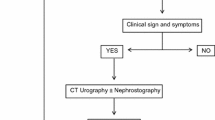Abstract
Introduction
Upper urinary tract is accessed for various procedures. The maximum numbers of procedures are carried out in prone position. Perforation of the colon is a well-known complication. The incidence of retrorenal colon varies from 10–20 % in prone position, but the chances of injury is around <1 %. These facts lead us to review the occurrence of retrorenal colon. The CT scan is imaging test of choice.
Objective
The aim of this study was to find out the occurrence of retrorenal colon at our centre and potential risk of injury to colon when kidney is punctured at various levels by percutaneous route.
Materials and Methods
It is a hospital-based descriptive type of observational study. We reviewed CT abdomen in supine and prone position in patients with different problems from January 2013 to December 2013. Inclusion and exclusion criteria applied. Colon posterior to the line as described by Prassopoulos and coworkers is regarded as retrorenal colon and being at risk.
Results
A total number of 700 patients were included, 350 each in supine and prone position. Patients had CT scan as a part of workup for pain abdomen in 27 % cases, calculus disease in 25 % cases, carcinoma bladder in 16 % cases and rest were of different diagnoses. Retrorenal colon was found in 2 % patients in supine and 6.8 % patients in prone position.
Conclusion
Considering the low incidence, the sample size in our study is small. We recommend multicentric large population-based study to establish the true incidence of retrorenal colon and chances of injury to colon.


Similar content being viewed by others
References
Segura JW et al (1983) Percutaneous lithotripsy. J Urol 130:1051
Rodrigues Netto N Jr, Lemos GC, Clara JFA (1984) Nova alternativa terasica na Litiase renal: litotripsia percutineapelo ultra-som. Ars Curandi 17:110
Valdivia UJG, Valle GJ, Lopez LJA, Villarroya RS, Ambroj NC, Ramirez FM et al (1998) Technique and complications of percutaneous nephroscopy : experience with 557 patients in the supine position. J Urol 160:1975–1978
Stables DP (1982) Percutaneous nephrostomy techniques, indications, and results. Urol Clin North Am 9:15–29
LeRoy AJ, Williams HJ Jr, Bender CE, Segura JW, Patterson DE, Benson RC (1985) Colon perforation following percutaneous nephrostomy and renal calculus removal. Radiology 155:83–85
Netto NR, Lemos GC, Fiuza JL (1988) Colon perforation following percutaneous nephrolithotomy. Urology 32:223–224
Boon JM, Shinners B, Meiring JH (2001) Variations of the position of the colon as applied to percutaneous nephrostomy. Surg Radiol Anat 23(6):421–425
Traxer O (2009) Management of injury to the bowel during percutaneous stone removal. J Endourol 23:1777–1780
Chalasani V, Bissoon D, Bhuvanagir AK, Mizzi A, Dunn IB (2010) Should PCNL patients have a CT in the prone position preoperatively? Can J Urol 17:5082
Hadar H, Gadoth N (1984) Positional relations of colon and kidney determined by perirenal fat. Am J Roentgenol 143:773–776
Hopper KD, Sherman JL, Williams MD, Ghaed N (1987) The variable anteroposterior position of the retroperitoneal colon to the kidneys. Invest Radiol 22:298–302
Tuttle DN, Yeh BM, Meng MV et al (2005) Risk of injury to adjacent organs with lower-pole fluoroscopically guided percutaneous nephrostomy: evaluation with prone, supine, and multiplanar reformatted CT. J Vasc Interv Radiol 16:1489–1492
Prassopoulos P, Gourtsoyiannis N, Cavouras D, Pantelidis N (1990) A study of the variation of colonic positioning in the pararenal space as shown by computed tomography. Eur J Radiol 10:44–47
Hopper KD, Maj MC, Sherman JL, Luethke JM (1987) The retrorenal colon in the supine and prone patient. Radiology 162:443–446
Prassopoulos P, Gourtsoyiannis N, Cavouras D, Pantelidis N (1994) Interposition of the colon between the kidney and the psoas muscle: a normal anatomic variation studied by CT. Abdom Imaging 19:446–448
Sherman JL, Hopper KD, Green AJ, Johns TT (1985) The retrorenal colon on computed tomography: a normal variant. J Comput Assist Tomogr 9:339–341
Dixon AK (1983) Abdominal fat assessed by computed tomography:sex difference in distribution. Clin Radiol 34:189–191
Meyers MA (1988) Normal anatomic relationships and variants. Dynamic radiology of the abdomen: normal and pathologic anatomy. Springer, New York, pp 27–48
Atar M et al (2012) Relationship between colon and kidney: A critical point for percutaneous procedures. Scand J Urol Nephrol 47(2):1–4
Alken P, Hutschenreiler G, Gunther R et al (1981) Percutaneous stone manipulation. J Urol 125:463–466
Matlage BR, Shah OD, Zagoria RJ et al (2003) Computerized tomography guided access for percutaneous nephrostolithotomy. J Urol 170:45–47
Conflict of interest
The authors declared that they have no conflicts of interest.
Ethical approval
Approval from hospital ethics committee taken and all patients were included after taking written informed consent.
Author information
Authors and Affiliations
Corresponding author
Rights and permissions
About this article
Cite this article
Sharma, G., Jangid, D.K., Yadav, S.S. et al. Retro-renal colon: role in percutaneous access. Urolithiasis 43, 171–175 (2015). https://doi.org/10.1007/s00240-014-0733-5
Received:
Accepted:
Published:
Issue Date:
DOI: https://doi.org/10.1007/s00240-014-0733-5




